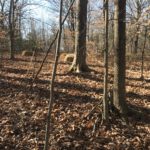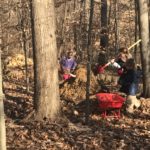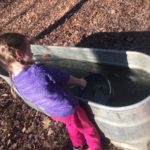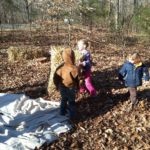Lessons in Den Building
By Dustin Pickett, CAPN Play Facilitator
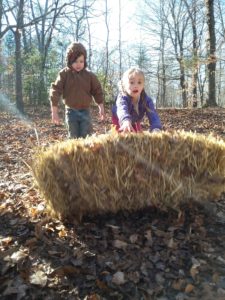 A couple of weeks ago I was invited to the Muddy Boots Play Group, a model forest kindergarten at Bernheim, to guide the children in a free play den-building activity. I arrived early to gather sticks, logs, and leaf duff into strategic piles. I was envisioning something like an A-frame debris shelter or lean-to big enough for a group of 10 kiddos to hang out. I enjoyed the quiet of the morning, crunching through the fallen oak, maple, and beech leaves, savoring the fresh cold air, imagining the fun we would have. The sky was open and the sunrise clear and bright. A good day to make a home in the forest.
A couple of weeks ago I was invited to the Muddy Boots Play Group, a model forest kindergarten at Bernheim, to guide the children in a free play den-building activity. I arrived early to gather sticks, logs, and leaf duff into strategic piles. I was envisioning something like an A-frame debris shelter or lean-to big enough for a group of 10 kiddos to hang out. I enjoyed the quiet of the morning, crunching through the fallen oak, maple, and beech leaves, savoring the fresh cold air, imagining the fun we would have. The sky was open and the sunrise clear and bright. A good day to make a home in the forest.
Soon after the children arrived, we gathered in a circle to talk about shelter building. First I asked the children to think of what they do to keep themselves warm. They looked around, silently processing, until someone recognized that they were all wearing coats! From there it was an intuitive jump to the various furs, feathers, nests and burrows we mammals use to protect ourselves from the elements. I asked for a show-of-hands: “Who here has ever built a fort?” All of the hands shot up. I asked each child what they like to use when they built forts. The answers ranged from couch cushions to blankets, chairs, boxes, strings and pillows. I asked the kids to think of what they would use to build a fort in the forest instead of inside their house. One child jumped off of her stump and shouted “sticks and leaves!” With a whoop and a cheer, we set off to our task.
Feeling confident that the children were primed for stick-and-leaf construction and would soon discover the piles I had staged, I stood back to watch the magic unfold. And it did… in ways I could never have anticipated. See, as a Free Play Facilitator with the Children At Play Network and a life-long outdoor skills nerd, I was excited to blend traditional instructive activities with the Free Play philosophy: child-led, freely chosen, personally directed, and intrinsically motivated. How would I find the balance between practical building skills and imaginative free play?
Well, the balance found me, as the children poured through the clearing and ran right past my curated piles without even noticing them. To my surprise, our friends were drawn immediately to a large clump of soil clinging to the roots of a fallen tree. They went at it with shovels, flicking the dirt into a wheelbarrow and scooping it with their hands.
One child had the idea to fetch buckets of water to mix with the soil. Soon the wheelbarrow was filled with a thick mixture of rain water, soil, sand, and leaves. I watched with delight as they churned it with whisks and spoons, sporadically checking the consistency with handfuls of their goopy wheelbarrow-mix.
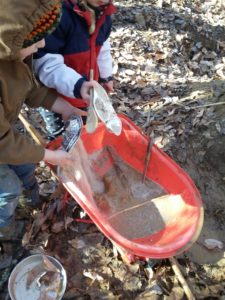 I realized with amazement that the children were well on their way to discovering mud-bricks, clay and adobe. All on their own, through their instinctual exploration and sensory inclinations! This was something I had not anticipated. I checked my grown-up urge to redirect them to the “actual” activity and instead held space for them to explore. Perhaps enough “seeds” had been planted in our pre-game discussion that they could discover the ways of den-building simply by following nature? Suddenly the task for me, as an educator, was not to teach them the proper techniques of shelter-building, but to trust nature as the true teacher.
I realized with amazement that the children were well on their way to discovering mud-bricks, clay and adobe. All on their own, through their instinctual exploration and sensory inclinations! This was something I had not anticipated. I checked my grown-up urge to redirect them to the “actual” activity and instead held space for them to explore. Perhaps enough “seeds” had been planted in our pre-game discussion that they could discover the ways of den-building simply by following nature? Suddenly the task for me, as an educator, was not to teach them the proper techniques of shelter-building, but to trust nature as the true teacher.
And then it happened. One little girl broke away from the group with a thoughtful expression. She walked slowly to a long, thick branch, the one I had hoped would be the “ridge-pole” for our shelter. She looked down at it. She hefted it and tested its weight. She found the balance point and surveyed each end. Then–slowly–she tilted it into an upright position and leaned it against the crook of a beech tree. I heard the 2001: A Space Odyssey theme erupt in my ears. Her face lit up and her eyes caught fire. She turned to the other children and she shouted: “Hey, we need to cover the sides of this and we can make a house of sticks and leaves!” They stopped and turned, frozen in place as their brains exploded with sudden inspiration. Soon they were running about, looking for new materials and methods to “get stuff up that high.”
What followed next was a host of other unanticipated experiments in physics. How to string tarps, what kind of sticks to use, how to get up high enough to place things. One child discovered that she could roll a large straw-bale down the hill by using a stick to leverage it up and with cooperation with other kiddos, to roll it the right direction. A whole lot of experimentation, trial and error, learning to resolve minor conflicts, and more: and all of it emerging from the children’s free interaction with the materials and space.
In the end, from an adult linear and goal-oriented perspective, the day was not very successful at all. We did NOT build an A-frame debris shelter. But the children’s faces were smiling and shining with absolute engagement. For them, the day was a tremendous success! They got to spend the morning in what we Free Play Facilitators call “flow state.” They were so completely immersed in their environment, they seemed to become part of the forest themselves. Children are biologically driven to learn through play. Holding the space to allow them to do so freely in a natural environment feels like watching a species being reintroduced to its habitat. If you ever wonder how our ancestors learned how to live in such elegant cooperation with their environments, all you have to do is spend some time watching children play freely in the woods.
